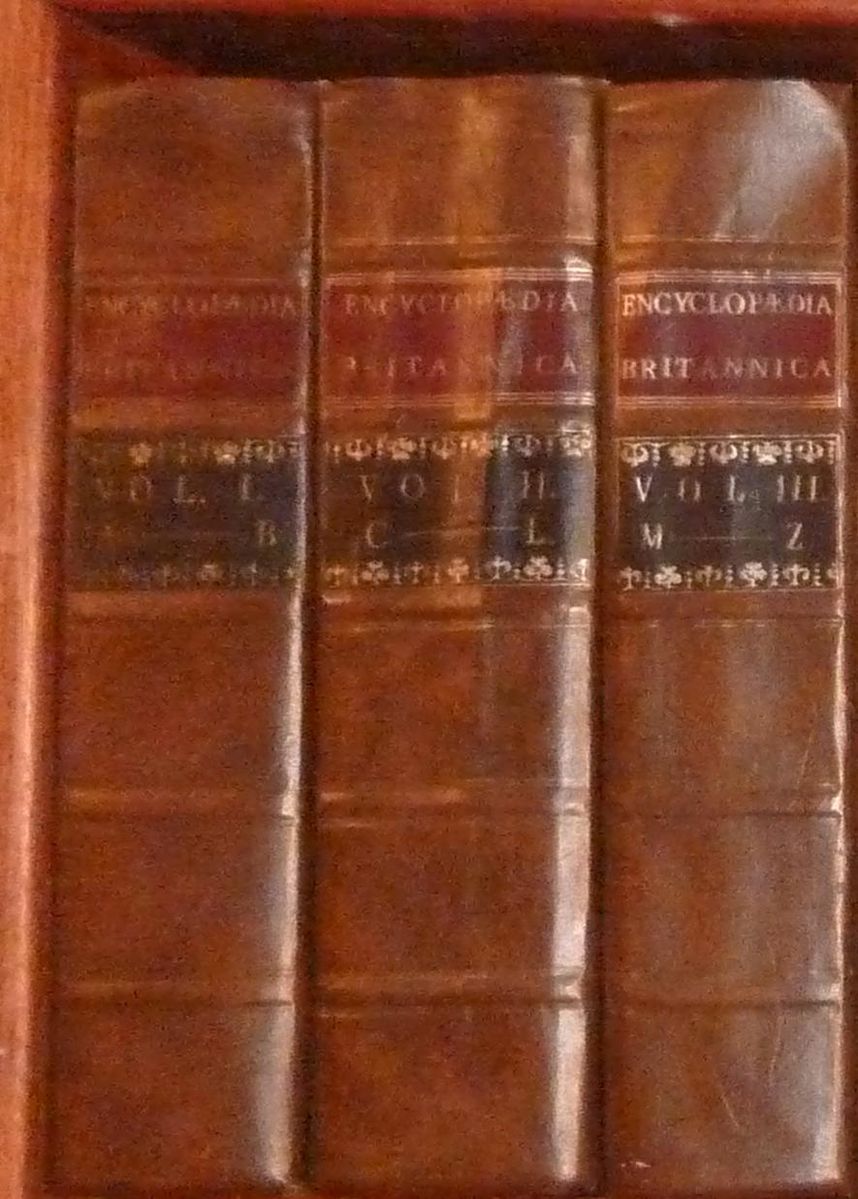Originally published 1768 | ||
 | ||
Similar Cyclopædia - or an Universal, The Children's Encyclopædia, Encyclopedia Americana, Encyclopædia Britannica Eleventh, Collier's Encyclopedia | ||
The Encyclopædia Britannica First Edition (1768–1771) is a 3-volume reference work, an edition of the Encyclopædia Britannica. It was developed during the encyclopaedia's earliest period as a two-man operation founded by Colin Macfarquhar and Andrew Bell, in Edinburgh, Scotland, and was sold unbound in subscription format over a period of 3 years. Most of the articles were written by William Smellie and edited by Macfarquhar, who printed the pages. All copperplates were created by Bell.
The Britannica was the idea of Colin Macfarquhar, a bookseller and printer, and Andrew Bell, an engraver, both of Edinburgh. They conceived of the Britannica as a conservative reaction to the French Encyclopédie of Denis Diderot (published 1751–1766), which was widely viewed as heretical. The Encyclopédie had begun as a French translation of the popular English encyclopedia, Cyclopaedia published by Ephraim Chambers in 1728. Although later editions of Chambers' Cyclopaedia were still popular, and despite the commercial failure of other English encyclopedias, Macfarquhar and Bell were inspired by the intellectual ferment of the Scottish Enlightenment and thought the time ripe for a new encyclopedia "compiled upon a new plan".
Needing an editor, the two chose a 28-year-old scholar named William Smellie who was offered 200 pounds sterling to produce the encyclopedia in 100 parts (called "numbers" and equivalent to thick pamphlets), which were later bound into three volumes. The first number appeared on December 6, 1768 in Edinburgh, priced sixpence or 8 pence on finer paper. The Britannica was published under the pseudonym "A Society of Gentlemen in Scotland", possibly referring to the many gentlemen who had bought subscriptions. By releasing the numbers in weekly installments, the Britannica was completed in 1771, having 2,391 pages. The numbers were bound in three equally sized volumes covering Aa–Bzo, Caaba–Lythrum, and Macao–Zyglophyllum; an estimated 3,000 sets were eventually sold, priced at 12 pounds sterling apiece. The First Edition also featured 160 copperplate illustrations engraved by Bell. Some illustrations were shocking to some readers, such as the three pages depicting female pelvises and fetuses in the midwifery article; King George III commanded that these pages be ripped from every copy.
The key idea that set the Britannica apart was to group related topics together into longer essays, that were then organized alphabetically. Previous English encyclopedias had generally listed related terms separately in their alphabetical order, rather like a modern technical dictionary, an approach that the Britannica's' management derided as "dismembering the sciences". Although anticipated by Dennis de Coetlogon, the idea for this "new plan" is generally ascribed to Colin Macfarquhar, although Smellie claimed it as his own invention.
Smellie wrote most of the first edition, borrowing liberally from the authors of his era, including Voltaire, Benjamin Franklin, Alexander Pope and Samuel Johnson. He later said:
I wrote most of it, my lad, and snipped out from books enough material for the printer. With pastepot and scissors I composed it!
The vivid prose and easy navigation of the first edition led to strong demand for a second. Although this edition has been faulted for its imperfect scholarship, Smellie argued that the Britannica should be given the benefit of the doubt:
With regard to errors in general, whether falling under the denomination of mental, typographical or accidental, we are conscious of being able to point out a greater number than any critic whatever. Men who are acquainted with the innumerable difficulties of attending the execution of a work of such an extensive nature will make proper allowances. To these we appeal, and shall rest satisfied with the judgment they pronounce.
Smellie strove to make Britannica as usable as possible, saying that "utility ought to be the principal intention of every publication. Wherever this intention does not plainly appear, neither the books nor their authors have the smallest claim to the approbation of mankind". On the occasion of the 200th anniversary of the 1st edition, Encyclopædia Britannica Inc. published a facsimile of the 1st edition, even including "age spots" on the paper. This has been periodically reprinted and is still part of Britannica's product line.
